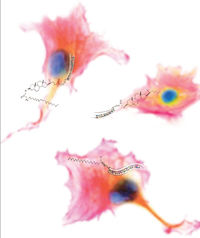Researchers map gene circuits that control cellular responses to metals
Possible applications to understanding bases for genetic diseases
Advertisement
Scientists at the Institute for systems biology (ISB) announced that they have developed a model of how cells respond to changes in composition of six different kinds of metals in their environment. While this study had a narrow focus, the implications of the results, and the systems biology approach used to study the cells, could be applied to studies of serious genetic diseases such as Menkes and Wilson's disease, and even Alzheimer's. These diseases have been connected with genetic defects in cellular functions requiring metals.
All living organisms depend on metals as vital partners for functions of many proteins. Humans, for example, extract necessary metals from the food they eat and traffic these metals through their bloodstream. If there is a defect in how proteins bind metals, or if the wrong metals get to the wrong proteins, it can result in serious health problems and genetic diseases. Therefore, knowledge of how metals effect changes in physiology is important to remedy health conditions associated with defective metal trafficking.
"Understanding metal-induced responses is a particularly complicated task," said Dr. Nitin Baliga, the senior author of the study, "because they include a complex mix of physiological changes directly associated with minimizing and reversing damage to cellular components and indirect cellular adjustments necessary for maintaining homeostasis."
Since cells are complex systems of interacting DNA, RNA, proteins, and metabolites, the traditional approach of studying responses of individual genes, or a handful of genes, one at a time is not suitable for capturing higher-level properties that emerge as an outcome of these various interactions. In contrast, a systems biology approach, which steers all research at ISB, enables scientists to simultaneously investigate all genes encoded in the genome at various stages of the intricate process, from the point when an organism senses a change in the environment, until it elicits an appropriate response.
In this study, researchers applied the systems biology approach to study physiological changes induced by fluctuations in metal composition. "Using this approach", said Dr. Baliga, "we were able to both understand the complex nature of metal-induced physiological changes in these cells, and, further, map the gene circuits that control the whole process."
The mapping of gene circuits gleaned from such research could be applied to understanding genetic defects underlying diseases such as Wilson's disease, which is a consequence of defective copper trafficking and, therefore, excessive copper accumulation in the liver or brain. Using a systems biology approach, scientists are beginning to understand how to find and remedy defects in genes that cause such complex diseases.
This study also has important implications in context of the explosion in genome sequencing in the last decade that resulted in the complete sequencing of hundreds of organisms. In this study, systems biology allowed ISB researchers to use the complete genome sequence of one of those organisms, Halobacterium, and apply it to this specific scenario in a much quicker and more holistic way. Halobacterium is an organism that thrives in extreme environments such as the Great Salt Lake, which has very high salt concentrations and therefore offer unique opportunities to mechanistically understand the limits at which life can be sustained. After the success of this study, ISB researchers see potential for further biotechnology and health innovations through applying this approach to other organisms from equally diverse environments for which complete genome sequences have been determined.
























































